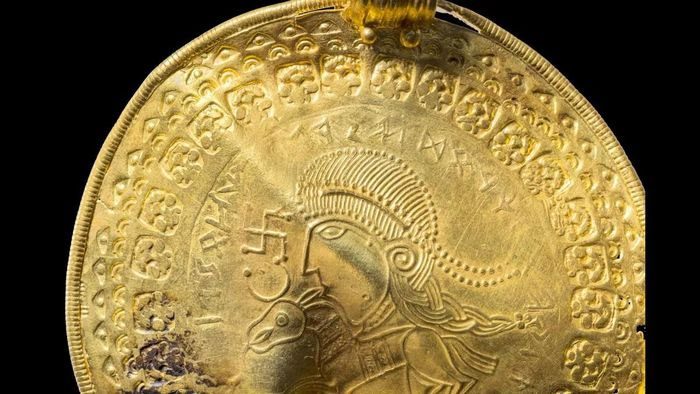A recently unearthed gold pendant in Denmark features the earliest known inscription referencing the Norse god Odin. Archaeologists believe that the pendant, made of thin gold and dated to the fifth century AD, predates the oldest known artifact mentioning Norse mythology by over 150 years.
Lisbeth Imer, a script researcher at the National Museum of Denmark, stated: “This is the first time in world history that the name of Odin has been mentioned. This means that Norse mythology may now trace its origins back to the early fifth century.”

The earliest known inscription referencing the Norse god Odin was found on a gold pendant in Denmark from the fifth century AD.
The bracteate – a pendant stamped from a thin piece of gold – bears a runic inscription that reads “He is a man of Odin” in an archaic form of the Norse language. It is believed to refer to the owner of the pendant, a leader or king from the Iron Age, who may have regarded this deity as an ancestor.
“I think the wording relates to a central motif describing Odin, a man with a horse, a leader or local king who claims to be a descendant of the gods and the god of kings. We have other literary evidence that kings liked to portray themselves as descendants of the gods.”
Imer and her colleague, linguist Krister Vasshus, spent over a year deciphering the runes on the pendant, which is part of a beautiful hoard of gold unearthed in Jutland, Denmark, in 2021.
Norse Gods
In Norse mythology, Odin is the king of the gods; the god of death, wisdom, magic, and runes; and is regarded as the “Father” of both gods and mortals. While Norse paganism features dozens of gods, Odin is one of the three primary deities worshipped in Norse religion, alongside Thor and Frey.
Odin is often depicted as having only one eye, as legend has it that he sacrificed his remaining eye in exchange for unparalleled knowledge. He also serves as the Norse counterpart of the German god Wotan and the Anglo-Saxon god Woden, though both of them are typically portrayed with two eyes.
Imer noted that the runic inscription appears to be more weathered than the rest of the pendant, possibly indicating that it was a sacred inscription touched for “gaining power.”
She added: “This was a time when religion was more integrated into daily life. Society leaders were responsible for religious activities and performed rituals to maintain good relations with the gods.”
However, it is challenging to interpret the small runes due to the words running together without spaces, and because the name “Odin” is written as “Wodnas” instead of the more common “Wodinas” – likely due to archaic writing conventions.
Primitive Vikings
Archaeologists believe that the Norse were descended from Germanic tribes that migrated into Denmark and other Scandinavian countries from around the fourth to the first century BC. After the eighth century AD, these seafarers became infamous as the Viking raiders of Europe. They established colonies in parts of England, France, Iceland, and Greenland for a time. Some Vikings even ventured to the Faroe Islands and modern-day Newfoundland in Canada.
The discovery of the inscription has influenced interpretations of engravings on other gold leaves; over 1,000 have been found throughout Scandinavia, with more than 200 containing inscriptions.
“The inscription on Odin’s pendant is actually copied from one of the other gold leaves from Vindelev with a slightly different motif,” Imer said. “But the engraver misunderstood the lettering, so many places only have a few strokes and messy lines.”
It also appears that the copied letters were stamped from the same mold as another one found in 1852 on the island of Funen in Denmark, which was donated to the National Museum, although its inscription has never been deciphered.
“Thus, the National Museum has possessed an inscription featuring Odin for 170 years – but only recently have we understood it,” Imer remarked.





















































